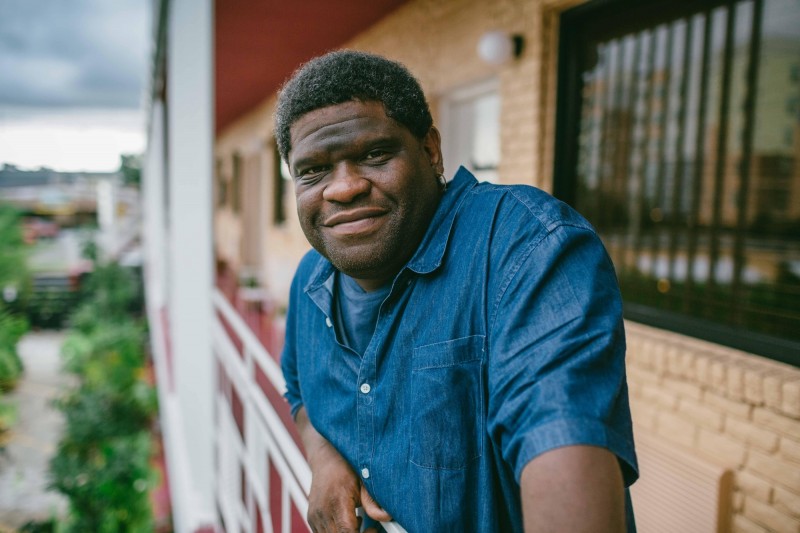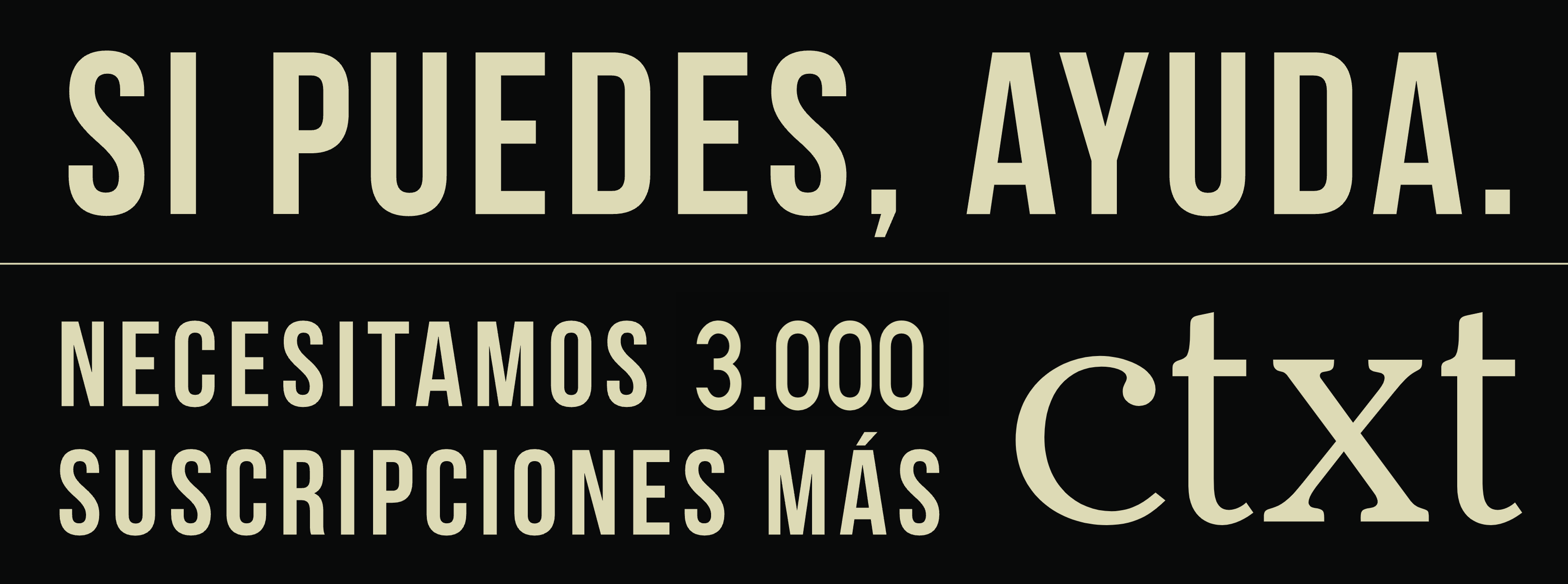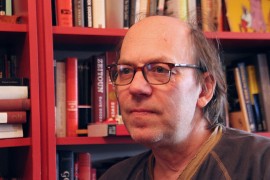Gary Younge / Journalist and writer
“Violence is more lethal in America, and the State is more deeply embedded in it”
Álvaro Guzmán Bastida 29/06/2020

Gary Younge, in a recent image.
Jonas MortensenEn CTXT podemos mantener nuestra radical independencia gracias a que las suscripciones suponen el 70% de los ingresos. No aceptamos “noticias” patrocinadas y apenas tenemos publicidad. Si puedes apoyarnos desde 3 euros mensuales, suscribete aquí
Before he moved back to his native Britain in 2015, Gary Younge had established himself as one of the most astute critical observers of American society. He had documented the delusional turn in the nation’s foreign policy following 9/11, chronicled its disastrous response to Hurricane Katrina, captured the enduring devastation of the 2008 recession, and deciphered the zeitgeist of the election of Barack Obama, constantly measuring the shadow of the triumph of the first African American president against the material realities of his presidency. Taken as a whole, his work for The Guardian, The Nation and other publications serves as a political topography of the decade leading up to Trump. It also prefigures a lot of the questions that have come to the fore since then. Halfway between anthropology and journalism, Younge excavated deep into American society in all its complex, multi-layered realities, including the anxieties of a white working class that was seeing its standard of living decline, the indignant roar of a then-nascent Black Lives Matter movement, and the open wounds of gun violence, which he immortalized in his book Another Day in the Death of America, published in Spanish by Libros del K.O. with the title, “Un día más en la muerte de Estados Unidos”. Throughout his time in the U.S., Younge confesses he developed “skin” in the American game, having fathered two American-born children and come to see the ugly realities of structural racism as something personal. I caught up with Younge via video call in Manchester, where he now works as a Sociology professor, to help make sense of the current moment of political upheaval in the U.S. following the killing of George Floyd.
When you left the US in the summer of 2015, after 12 years covering it for The Guardian, you wrote a piece in which you lamented the predictable, endless repetition of high-impact killings of African American men at the hands of police. If we fast forward to the current moment, there’s a series of events that led to this explosion of popular rage. Most obviously the murder of George Floyd by Minneapolis police officers, but also the emergence of the video about the hunting down and shooting in cold blood of 25-year-old African American Ahmaud Arbery by a retired police officer and his son in Georgia, and the killing at the hands of the police of Breonna Taylor, a black healthcare worker who was shot eight times while in bed in Kentucky. What’s going on? What’s the larger context in which all of this is happening and what’s unique about this moment?
There’s a sense of almost mystery about the alchemy that makes any particular moment totemic. One can speculate about what it is in these moments, but I would say that you could put those three things you mentioned together pretty much at any particular given time. I do believe that Trump, his brazen encouragement of white nativism, his clear, blatant disregard for black people, his open racism and xenophobia has, in some senses, cleared the space for a bigger conversation about race. The presence of Obama, in some ways, suppressed a broader conversation one might have about how American power and white racism work. Whereas Trump, conversely, inflames whatever question you might have.
There was a lot of oil on the floor waiting for a spark and George Floyd’s murder was the spark
I don’t say this in any sense of clairvoyance, but if you read the first four paragraphs of that article, it talks about “there will be a man in the summer… A policeman will kill him... We don’t know who he is and we don’t know why his death in particular, and it probably will be a him, will do this.” There was a lot of oil on the floor waiting for a spark and this was the spark.
A lot of your work has focused on the inherent violent realities of the American political economy. What are some ways in which that violence is manifested, affecting black Americans in particular?
America is a more lethal country. Quite simply. White people are more likely to be shot there than we are anywhere else. White people are more likely to be shot by the police and more likely to shoot each other and more likely to shoot themselves. It’s one of the few Western countries, maybe the only Western country that still executes people. It has an obscene incarceration rate. The violence there is more lethal and the State is deeply embedded in the system of control that police has in some areas as those they’re occupied territories.
You also mentioned the way in which COVID-19 is affecting black populations more disproportionately. Why is that? Would you say it’s having an impact in what we’re seeing?
It’s clearly having an impact. George Floyd’s murder, on its own, could stand as racism. This is what racism is. With COVID you see the more systemic, subtle form. Black and Latino and African American people are more likely to die, because they’re poorer. And actually, COVID will kill far more of them than the police ever will. These things are connected in the systemic racism. What we see with the policemen caught on video is the most brutal, the most brazen, the most clear and the most obvious form of racism. What we see with COVID is the more sinister, more covert, more systemic, institutional, statistical drumbeat to which Americans go to their deaths. That is the connection.
The same week that George Floyd was murdered, a video emerged of the white woman in Central Park who called the police on a black bird watcher and lied saying, “an African American man” was “threatening” her life. You’ve written about the seemingly banal ways in which racism is manifested in America, including on yourself and your own son. What does a scene like the one in Central Park suggest and tell us about that racism?
I actually think that snapshot actually tells us a great deal. It’s very telling. Amy Cooper, the white woman, is an Obama-loving Democrat, a New York liberal, making $170,000 a year. She didn’t go up to the park thinking I’m going to get a black man killed or arrested, but all of her reflexes show you how she understands the world. What’s remarkable is that she loses everything. She is fired from her job. They take away her dog. She’s banned from Central Park. Of course I think what she did was wrong and deplorable and so on, but the real obscenity is that we know that she did that because that would be a possible death sentence. That any black man would be worried at the notion of the police coming. That what she invoked was the wrath of a racist State.
We individualize it and we talk about her, but she was doing what we all know to be true, right? By calling the police and sounding like she was even being raped by a mad, dangerous, African American man, she knows that the impulse of the American State means that his life will be in danger. That’s why she assumes that he will back down. When he doesn’t, she gets more and more shrill. It speaks to the degree to which the impulses of your liberal, Northern, New York, Democrat-voting white person can be, in many ways, not that different from the rest of America. It shows you how embedded the problem is.
You mentioned this in passing, but there are two statistics that those interested, both in America and outside of it, in shutting down the debate about systemic racism like to air out. One shows that white Americans are killed by police more often than black people. The other is the proverbial “black on black crime,” the fact that more African Americans died at the hands of other African Americans than of any other group. What do those statistics obscure?
The first one’s daft. Of course more white people are killed, but African Americans make up 12% of the population. It would have to be completely obscene for African Americans to make up a greater number of those who are killed. The point is that they make up a massively disproportionate number of the people who are killed. Nobody with any kind of context suggested that black people are the only people in America who suffer from civil rights abuses. Of course not. It’s a matter of proportion. It’s the likelihood. It’s not a number.
If one understands America historically, 200 years ago was a slave State, 100 years ago it was an apartheid State. It’s only been a non racial democracy for 55 years
Then the second thing of black on black crime. In America, crime, like life, is segregated. White people kill white people. Black people kill black people. Latinos kill Latinos, by and large. But you only get black on black crime. When you have a term which is only used for one racial group and nobody else, then what you have is a racist term.
In “Another Day in the Death of America”, you chronicled the short lives of children and adolescents who fall victim to gun crime in the United States on the same summer day in 2013 and how black youth are, again, disproportionately affected. In what ways is gun violence reflective of that system of institutional racism?
All the kids who died that day were working class. The poorer you are, the more likely you are to not have parents who have the time to take you from one event to another, to go to a school that does not put on the kind of extracurricular activities that would keep you occupied, to know other people who have been killed. The more likely you are to live in an area where the police treat people in a certain way. The less likely you are to live in an area where death will be pursued by the authorities.
The wealthier you are, the more likely you are to have parents with the actual and cultural capital to provide you with a series of alternatives, to get you out from wherever you are by the age of 18 and into university, for example. In all sorts of ways, these people live in the poorest, least well policed, least well educated areas with high amounts of unemployment, poverty and deprivation. Across the world. Those are the areas where you will find most crime, regardless of race.
The segregated nature of black in America makes it more racialized. Is that what you’re saying?
That’s what makes it more racialized, yes. Once again, to take your point about numbers, usually roughly about the same number of white kids as the black kids get shot dead on average. Any given time. But once again, it’s disproportionate because black kids are much fewer. The nature of American poverty is racialized. There are large areas of concentrated black poverty, which, to be honest, the geography of whiteness isn’t working in quite the same way. If one understands America historically, 200 years ago it was a slave State, 100 years ago it was an apartheid State. It’s only been a non racial democracy for 55 years. One of the tricks of American reinvention is to make you wonder. “How could this be? Everybody is born with the same rights,” and so on. But that’s evidently not true.
That brings up the question of race versus class. There’s a tendency to bifurcate the two, as if it’s an either or question, in terms of what is the source of the deprivation, of exploitation. What does your work about life in America tell you about the ways in which those two questions, race and class, are interconnected and they interplay?
Any attempt to understand them separately is to misunderstand them both completely. You can’t understand class in America without understanding race. It doesn’t make any sense. Who’s doing the work? Why is some work paid at some levels and some work paid at other levels? You’ve to look at how American wealth was accumulated, at who gets to be a fireman or a cleaner. It’s a kind of de-desegregated society. Similarly, it’s important to try and understand how racism operates in a country with a significant black middle class with the likes of Condoleeza Rice and Colin Powell. Anything that affects the poor will affect black people disproportionately. Any gains that black people make will enrich the poor as well. That doesn’t mean that most black people are poor. Although, with this new crisis on top of the 2008 one, we’re getting to that stage. African Americans lost a huge amount of wealth in the last crisis. They’ve barely gotten out of it and here we are again.
A lot of that drop in the standard of living happened during the Obama presidency, which you covered in its entirety. In your work, you chronicled the ways in which black Americans were faring worse, both in absolute terms and relatively to whites, by the time he left office compared to when he took power. Black Lives Matter emerged under him, and you claimed incredulity at the level of disappointment in his tenure when he had promised so little. What’s your assessment of Obama’s presidency?
Obama’s primary value was symbolic, not substantial. And symbols matter. What was interesting when Black Lives Matter started was that it happened almost without reference to Obama. When those things erupted, very little was demanded of him. Very little happened. There was not much of an audience of the notion that there was a contradiction here between the jubilation of having a black president and the fact that black kids can’t walk down the street without getting shot dead.
Obama is a symbol of a huge amount of pride for African Americans. And yet, during his tenure, the gap between black and white wealth and income rose
Obama is the picture in a barber shop, in the bodega, in the diner. He’s a symbol of a huge amount of pride for African Americans. And yet, during his tenure, the gap between black and white wealth and income rose. That’s the facts. But the perception was very different. People were saying his Presidency showed that life for African Americans was getting better. Literally, they were saying that as it was getting worse. His legacy was one of that sense of pride that never went away. And actually, he becomes revered when his successor is Trump. You go from a President that’s consensual, articulate, soulful, cosmopolitan, mixed race, which kind of matters.... To this bizarre, orange bigot. Even George Bush looks good at this moment. So the mythology around him, which was already quite considerable, has grown immensely as a result of what went after. The performative contrast between him and Trump is huge. But it’s not like he’s come up with some substantial idea for what would be the difference here.
What do those failings, or the failure to live up to that mythology, as you mentioned, tell you about the politics of representation and the Democratic Party? Minneapolis is a very progressive city with Democratic mayor. The chief of police is a black reformist.
It tells you two things. First of all that you can’t have a group of people shut out of representation. So it matters. But that, in itself, does not ensure equality. If you’re talking about diversity in terms of who gets resources and power, that’s one thing. And that’s very important. If you’re talking about diversity in terms of who is at the head of the system, that’s a different thing. Angela Davis called it, in an interview I did with her, “the difference that makes no difference and the change that brings no change.”
When people are elected as tribunes of their race or their gender or whatever, as for example Jesse Jackson would have been in ’84 or ’88, that’s very different to the way that Obama was elected as a regular democrat. It is possible to look different and act the same. If you have a racist system, then it really doesn’t matter the color of the hand that’s on the system.
In that vein, you’ve warned democrats, and Joe Biden in particular, against taking African Americans for granted. What do you mean by that and is there a history of that?
Yeah, there’s a huge history of that. “Just get black people to the polls and they’ll vote Democrat. They’re not going to vote Republican.” The Democrats have only won one election since the Second World War with the white vote alone. That was in ’64. So they’re absolutely reliant on the African American vote. But they deliver very little. A lot of what they deliver is very performative. Bill Clinton was actually a much more powerful illustration of the problems with the politics of representation than Obama. He knew the words to the black national anthem. He was a Southern boy. He was very familiar with the poetry of Maya Angelou. There was a folksy performance that African Americans loved. But he was also the man who passed the laws that put more African Americans in jail than anyone else before. He was the one who flew back to Arkansas to make sure that a black man who was so impaired that for his last meal he saved the dessert to have it afterwards would be executed. He said, “They won’t get me on law and order.”
The Democratic Party, partly because of its history in the South, but also because it’s a party embedded in the big money and all of the awful things that make American democracy not democracy, is not a party of the working class. It’s definitely not a party for that group of people who need fundamental change, who need a kind of marshall plan for the urban areas. It never has been really. It’s a party of somewhat responsible business. In most western countries, it would be the center right party, much more right wing than the Christian Democrats in Germany.
And yet Trump, going back to the comparison with Obama, is undoubtedly a qualitative step above that systemic racism you’ve been denouncing. How do you read his association with white nationalists, which seems to be becoming even more explicit? What’s it a sign of?
He’s increasingly dependent on the greater devotion of a smaller number of people. In the past, there was the dog whistle, so that only the dogs could hear it. Nixon told his chief of staff, "You have to admit that the whole problem is really the blacks. The key is to devise a system that recognizes that while not appearing to.” That is how the Republicans managed to take the South and keep those elements of Northern suburbia. That you don’t talk, as Trump does, about shithole countries and rapists and so on. You talk about welfare moms or crack babies or urban crime. You find a way to signal blackness. That offers plausible deniability, but everybody knows what you’re talking about.
The people who support Trump are much more likely to vote than the people who support Biden
What Trump has is the wolf whistle. He has people beaten up at his rallies. He wants to make ANTIFA a terrorist organization. He talks about the far right people demonstrating in Charlottesville, saying there were some good folks there. It’s a scorched earth approach. He makes it very naked, as opposed to subtle appeals to a white nativist sensibility. The longer it goes on, and particularly during COVID, when the sheer incompetence is evident and he’s increasingly losing people in the suburbs, white Catholics and some white evangelicals, he becomes more and more shrill and brazen. Hence the standing with the bible getting people cleared. There is no other option for him. His election was very narrow. His support has shifted quite substantially since then. He has the benefit of a very weak opponent in Joe Biden and so his desire, his aim, is to galvanize his base. The people who support Trump are much more likely to vote than the people who support Biden. Biden’s been told a significant section of people who supported Bernie Sanders still aren’t committed to voting for him. The Democrats’ base is broader but much softer. Trump’s base is narrow but he’s doing his best to really motivate him and that’s what the rhetoric is about.
Let’s turn back to the current wave of protests. The violence in some of those demonstrations and how they turned into riots has led to condemnation, not just by Trump. There’s a lot of anxiety in the mainstream media and the center left. You wrote a book about Martin Luther King’s famous "I Have a Dream" speech. A lot of people who don’t seem very comfortable with some of the violence are invoking his legacys. Is the violence we’ve been seeing justified? Is it effective? And what does the legacy of Dr. King say about this?
I think a way to understand political violence like this is first of all to look at violence in its entirety, at the economic violence. The fact that a black man in Washington DC has a lower life expectancy than the man on the Gaza Strip, the massive poverty, the disproportionate people who suffer destitution, the massive incarceration, the disproportionate amount of execution, the rates of infant mortality. The violence doesn’t come from nowhere. It’s a response to the violence that already exists. That’s both true generally and specifically in the case of the police.
It’s not possible to talk about one moment of violence without talking about the broader context in which that violence exists. In that sense, is it justified? Well, I would say if other means of protesting state murder have been exhausted, then yes. You have a significant group of people living in a state of tyranny and revolt against that tyranny. I think that that is justified if other means have been exhausted. Everybody’s taking a knee now, but when NFL player Colin Kapernick took a knee they took him out. When the footballers were taking a knee with him, they were basically told they couldn’t do it anymore. Unless you honestly think a letter to your congressman is going to stop these deaths, unless anyone can point to a peaceful avenue that was not pursued, then what do you do if you live in your own country and you can’t walk down the street without fear of being killed by the police?
Is it effective? In terms of drawing people’s attention to the issue at hand, yes. Would we be talking about George Floyd if the fires didn’t burn? I don’t think so. Minneapolis has disbanded its police force. Would that have happened if the fires hadn’t burned? Would the NFL have said we understand why people take a knee? I don’t think so. And historically, when there have been riots, in the wake of those riots there have been gains, because the system has been challenged. It was the protests in the 60s that started out peaceful but ended up violent. That’s when the black American middle class came from, that’s where Obama came from.
But generally, the people who riot are usually not the people who gain. The gains go elsewhere. Kind of up their social ladder. The beneficiaries are generally the middle class, not the protagonists of any major rebellion. And they’re not in themselves equipped to solve the problem that they raise. They are polarizing. They’re often hyper masculine. So they’re deeply problematic and they shouldn’t be fetishised, but there also is a squeamishness about political violence that denies every other kind of violence that made it possible and likely, and also ignores all other attempts that were made that were not violent.
The invocation of Martin Luther King is just illiterate. King said, “I cannot condemn the violence here without condemning the greatest purveyor of violence in the world today, which is my government.” He said that he understood why people rioted in Chicago. He said, “I didn’t deliver to them. I won them the right to eat in any restaurant but they couldn’t afford what was on the menu.” That King called for, or embraced socialism. He asked, “who owns the iron and the water and the oil?” He himself died as a victim of violence. Any notion that they are violating King’s dream fails to understand the full scope of what he was after. In his “I Have a Dream” speech in ’63, he talks about coming to Washington to cash a check. That the check that was written out to the American people bounced. That it came back with insufficient funds so we’re here today to cash that check. Well that check’s still not been honored.
A lot of people that are seeing echoes in the 60s and the current moment. But the 60s have a complicated legacy. A lot of civil rights victories were achieved but not only was Martin Luther King murdered, but Nixon ended up in the White House on the platform of law and order. Do you see echoes of the 60s in what’s happening today, and what are some lessons to be drawn from that era?
I don’t see echos. I don’t. I mean people are on the streets and they were on the streets in the 60s. To that extent, that is the same. The 60s were started with a civil rights thing about voting. Voting rights in the South. Then progressed to issues of economic rights, mostly in the north. New York and Chicago and elsewhere. Most of the atrocities that we’re seeing now, they’re not happening in the South. You mentioned Minneapolis. The racial situation is no longer regionalized in that way. The 60s had movements. Black Lives Matter isn’t a movement exactly. It’s a hashtag. It’s not like if you go to Chicago you would find a Black Lives Matter office. That’s not to denigrate what they do, at all. It’s just a different metabolism. There’s no structures. There’s no meetings. There’s no internal coherence. It’s a kind of floating signifier that can attach itself to any kind of protest. The Southern Christian Leadership Conference and the Black Panthers did have a mass base in a way that these don’t.
The uprising or protests have achieved some concrete victories, such as the announcement of the disbanding of police in Minneapolis, but also some more symbolic ones like tearing down statues of slave traders and confederate generals across the country. They’ve also also set some very ambitious goals about abolishing police and it’s been met with really violent oppression. Yet polls in America seem to suggest that it’s captured the public’s imagination. The support of Black Lives Matter is on the rise. What gives you hope about the current moment and what gives you pause?
These moments always carry significant risks. And as you rightly pointed out, the 60s ended up with civil rights, voting rights and Nixon. One shouldn’t expect an unequivocal set of gains. Trump reacted by assembling the National Guard at the click of a finger, but they cannot get PPE or tests and trace. These are historically fairly consistent responses to black rebellion. What’s new, in a sense, is the degree to which there wasn’t significant symbolic pushback. Large numbers of people, who would normally, in a polarized moment like that, move to the side of law and order and so on, were like, “Well, you can see where they would come from.”
So the issue of policing and racism is now front and center in a way that was not true before. There is a much more serious conversation than I’ve ever seen about not just that policeman or that moment, but policing, how it is done and who it is done to and who it is done for. It has opened a door to a significant critique of the way that State powers are exercised on a street level. And it has, so far, managed to polarize people in a way that hasn’t left the protesters completely isolated. The support, not necessarily for the riots but for the sentiment, has been broad. So that’s helpful.
But the fear is that this level of protests can’t be sustained indefinitely. We have a very weak Democratic Party candidate, a very racist president, and electoral politics that cannot be sustained in this moment. That leaves a significant space for opportunists of all kinds. Over the past decade of discontent, the Left has proven much better at clearing space than at filling it. And I fear that Trump’s weakness may be temporary. If put on the spot, Joe Biden won’t have the kind of answers that really resonate, that really make people think that he would do any better. What that ends up doing is making people cynical and disaffected and that would be the worst of all worlds.
Before he moved back to his native Britain in 2015, Gary Younge had established himself as one of the most astute critical observers of American society. He had documented the delusional turn in the nation’s foreign policy following 9/11, chronicled its disastrous response to Hurricane Katrina, captured the...
Autor >
Álvaro Guzmán Bastida
Nacido en Pamplona en plenos Sanfermines, ha vivido en Barcelona, Londres, Misuri, Carolina del Norte, Macondo, Buenos Aires y, ahora, Nueva York. Dicen que estudió dos másteres, de Periodismo y Política, en Columbia, que trabajó en Al Jazeera, y que tiene los pies planos. Escribe sobre política, economía, cultura y movimientos sociales, pero en realidad, solo le importa el resultado de Osasuna el domingo.
Suscríbete a CTXT
Orgullosas
de llegar tarde
a las últimas noticias
Gracias a tu suscripción podemos ejercer un periodismo público y en libertad.
¿Quieres suscribirte a CTXT por solo 6 euros al mes? Pulsa aquí







